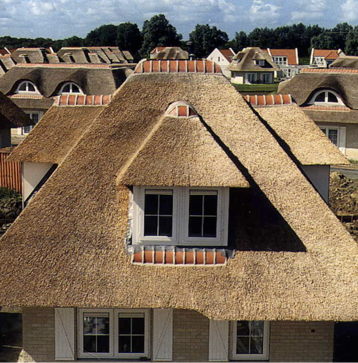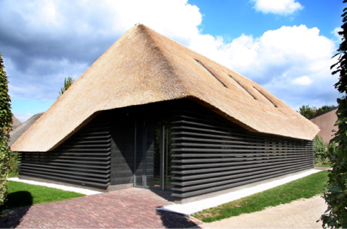Thatch Roofing
Thatch has to be one of the most recognizable and yet least knowable of all roofing types. These roofs have been featured in movies and are associated with many an illustrated children’s fairy-tale. Still, homes with thatch roofing are a mystery to Americans because they are essentially non-existent in the US.

Much of the building technology used today is a result of our ancestors simply having to quickly and cheaply create shelter for themselves. The use of thatch for roofing is certainly an example of this. The use of organic materials like leaves, palm fronds for roof covering goes back thousands of years. Thatch use evolved because it was readily available, cheap and lightweight. People of old, built their own homes and though they may have been amateurs with unsophisticated methods, the constructions were still done with a high degree of skill, mostly developed through trial and lots of error.
The use of thatch grew steadily during Norman times and this popularity remained until devastating fires wiped out much of London from 1077 through 1202. Finally, in 1212 authorities decided that something had to be done, and the first building code in London was enacted. The Ordinance of 1212 essentially prohibited the use of thatch. That date marks the beginning of the decline of thatching and the birth of the making of tile for roofing.
Thatching continued to decline all through the 1800’s as production of Welsh slate increased on a massive scale. The French wars and the two world wars all had a negative effect on the industry as well. Since the 1970’s though Thatching has seen somewhat of a rebirth to a point that now it is considered a potential growth industry albeit on an extremely custom basis.
The common materials used for thatch are Norfolk water reed and winter wheat straw. Sedge is used for ridge material. Sedge grows in the same areas as water reed and is maintained as complimentary crop.
Installation techniques vary according to the material being used and to regional traditions and styles of the trades folk. Like many tradecrafts, specific methods and techniques are handed down to family members and workers through experience. Even so, basic procedures call for starting the work at the eaves and progressing up the roof plane with overlapping courses to finally terminate at the ridge. Schools in the UK offer six-month training programs for adults to learn the art of thatching. Successful graduates will come away with about 80 percent of the knowledge needed to become a master thatcher.

The material is fastened to the timbers and framing of the roof structure. The thatcher must lay the straw in a manner that will shed rainwater from all areas of the roof without it penetrating to the interior and framing. There are few rules and each craftsperson must choose methods to suit the conditions presented to him or her. For this reason, thatch roofs are unique, and no two roofs are ever the same.
Properly installed and maintained thatch can last from 50-80 years. Natural wear and tear occurs from a number of external forces like rain, wind, frost and birds. Most of these can be overcome by good maintenance efforts by the homeowner. Preventive maintenance is necessary in order to get the full value from a thatch roof. Window cleaning, chimney cleaning and painting has to be performed carefully in order to avoid damage to the thatch. The roof should be inspected annually, and any damage found should be corrected immediately.
Thatch lasts longer when kept out of the overhang and shade of trees. Sometimes, sprays may be needed to prevent deterioration from fungus and parasites. Birds can be especially damaging to these roofs and repairs should be made when problems are found to prevent nests from being built.
The most obvious problem with thatch is its susceptibility to fire. While there is no treatment that can be applied to render thatch non-combustible, there are some products on the market that can provide a temporary, limited degree of protection. Smart prevention is the key. Modern installations require a layer of barrier foil be applied to the framing prior to being overlain with thatch. Besides helping to make the structure more fire resistant, the foil also acts as barrier to thermal radiation to help keep the interior cool.
Thatch is one of the most aesthetically unique materials for roofing one can consider. If you are intrigued by an unusual, hand crafted roof with fairy-tale appearance, thatch may be just what you are looking for.
For more about thatch roofs and roofing I recommend reading a copy of Thatch by Robert West. A complete guide to the ancient craft of thatching.









